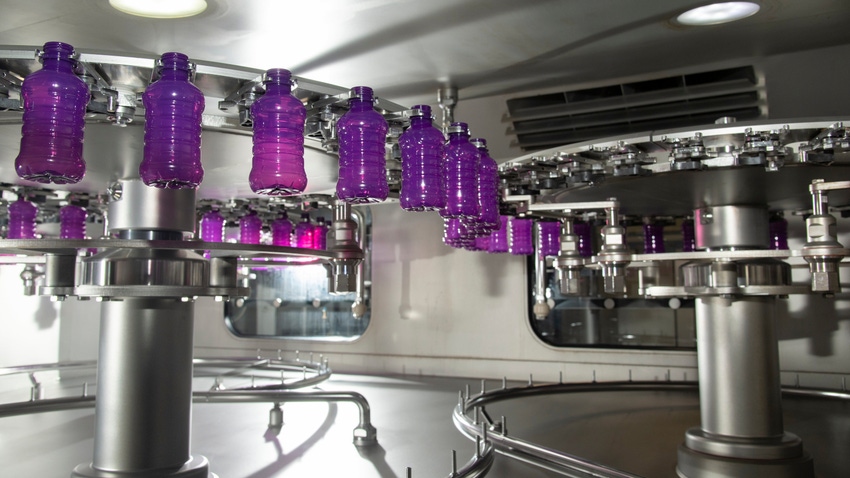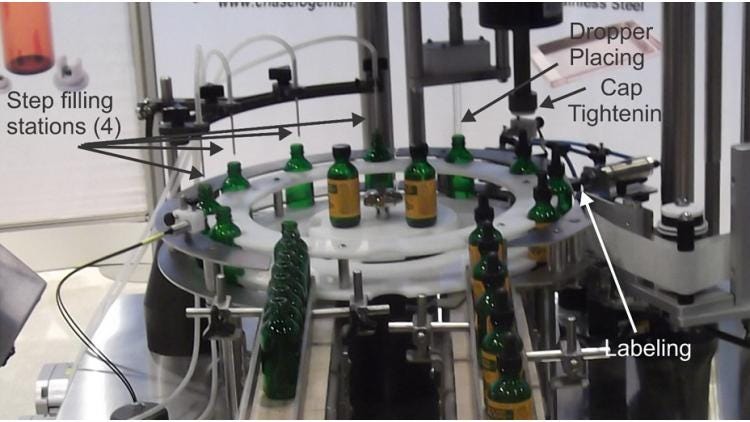March 24, 2020

Before you set up your next packaging line, consider these pros and cons of monobloc packaging machines: container control and floorspace, and flexibility and maintenance.
Monobloc packaging machines combine two or more major functions in a single machine. The term is most commonly used to describe systems at the head end of a bottling line but can be applied to other machinery as well.
For example, this machine incorporates filling, capping and labeling on a single machine at about 80 products per minute.

For primary packaging, monobloc machines combine filling, capping, and labeling operations on the same machine base. Photo courtesy of Chase-Logeman Corp.
On a larger scale, other packaging machinery manufacturers provide high-speed monobloc machines that blow-mold, fill and cap on a single machine at speeds of 1,300 bottles per minute or more.
At the end of the line, monobloc machines can combine multiple secondary packaging functions onto one frame, such as a case erector-packer-sealer.
The pros.
Monobloc machines offer a number of advantages. The most relevant are (1) better container control and (2) floorspace efficiency.
In a typical bottling line, filling and capping are separate systems. The bottle enters the filler and is captured and positioned with a timing screw, starwheel, or other package-handling device. The bottle is filled, then released. A conveyor carries it to the capper where it must be captured and controlled again.
If the machines are separate, there needs to be a control system to match the speed of the capper to the filler. On lower speed lines, this is typically a sensor that starts the capper when bottles back up and stops it when bottles run out. More sophisticated systems can vary the speed of the capper to maintain a constant backlog.
In the past, some high-speed lines ran all machines off a single large motor with a line shaft connecting them physically. A timing screw synchronized the movement of bottles between machines.
These line shaft machines worked well controlling the bottles through the line but were bulky. They were precursors to monobloc machines.
This brings us to the second big monobloc advantage: floorspace.
In the bottle filler-capper-labeler example above, each of the three machines, if standalone, could take up roughly the same amount of floorspace as the one multi-function monobloc.
The monobloc is approximately 6 x 6 feet (36 ft2). The individual machines might be 4 x 4 feet each (48 ft2 total),not counting connecting conveyors. Floorspace is limited and expensive. Monoblocs conserve this valuable resource.
The cons.
It’s not all upsides. There are drawbacks.
One is flexibility. An individual filler can be repurposed elsewhere in another line or even industry. The same applies to the capper and labeler. A monobloc is designed for a specific series of operation. If the product requires a crimped cap instead of a screwcap, for example, it may be difficult or impossible to reconfigure the machine. If marketing decides that the bottle needs to be rectangular instead of round, the labeler will no longer work. Standalone machines will have more flexibility for reconfiguration as packages change.
Another drawback is maintainability. As more functions get crammed into a smaller space, complexity multiplies, and the machines get harder to work on.
If a standalone capper, for example, goes down, it may be possible to cap by hand or bring another capper to the line. If the capping, or any other section, of the monobloc machine breaks down, the entire machine is dead.
Monobloc or multiple machines? Each approach has its attractions. Before deciding which is right for your particular applications, consider each carefully.
About the Author(s)
You May Also Like


